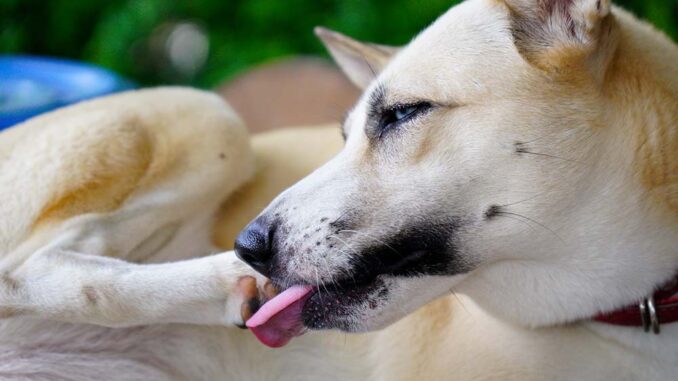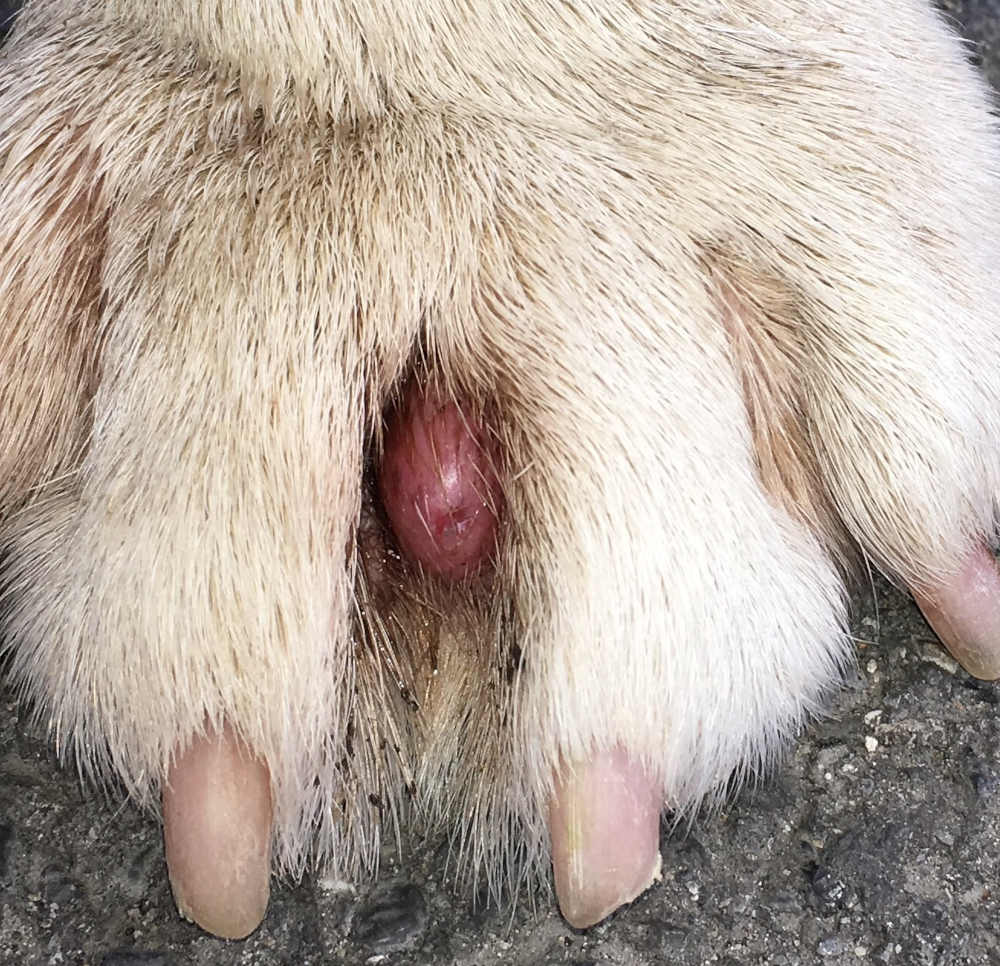
This article was updated on January 10th, 2024
In this article, we will discuss interdigital cysts in dogs, including causes, symptoms, prevention strategies, and effective treatments to ensure your canine companion enjoys optimal paw health.
What are interdigital cysts?
These red bumps pop up between your dog’s toes and are often filled with blood or pus. They can become quite large. If painful enough, your dog will either limp or lick them excessively.
The cysts seen on the top of the paw and between the toes manifest from an area of diseased skin on the bottom of the paw. When the bottom of the paw is examined, you may see areas of hair loss, redness, swelling and comedone (blackhead) formation.
Pictures
You can see an image below or here on KaringalVet.com.

How do dogs get interdigital cysts?
Most dogs who develop interdigital cysts have atopic skin disease. Interdigital cysts develop from irritated or plugged hair follicles. They are likely to form:
- In dogs with underlying skin allergies.
- After an injury due to e.g. walking on gravel
- In obese dogs, as they put more pressure on their paws
- In dogs that have difficulty walking
- From an irritation such as licking
- In dogs with thick, short-haired coats that are prone to ingrown hairs. This includes Boxers, Bulldogs and Pitbulls.
What can I do from home to help my dog?
From home, we should be trying to determine why our dog has developed this cyst. Are they over-weight or prone to itchy skin? Have they recently been walked on rough terrain or are they compulsive paw lickers? Identifying the trigger is key when it comes to managing any current cysts and preventing further ones.
We should try to minimize risk factors, which can include keeping our dog slim and preventing excessive paw licking. If our dog has allergic skin disease, we should be trying to keep on top of this with e.g. allergen avoidance, hydrolyzed diets, skin supplements, medical shampoos and daily medications such as Apoquel (Oclactinib).
Some dogs benefit from regular cleaning of their paws with medicated washes such as Chlorhexidine. These washes help to reduce yeast and bacteria in between the toes. After leaving the lather on for 5 minutes and rinsing, we should then dry in between the toes well using cotton wool.
When should I see my vet?
Interdigital cysts do cause dogs pain and they often prove difficult to treat effectively. Any new cyst or growth on a dog’s paw should be checked over by a vet so we can confirm what it is and start the right treatment plan.
If we do not address the issue promptly, this can lead to chronic inflammation, scarring and long term pain. So, seeing your vet early on is strongly advised if an interdigital cyst is suspected.
Treatment options and costs
Frustratingly, these types of cysts are not always easily treated and they are notorious within the vet community for resisting treatment and/or coming back. The best treatment will address the cause of the cyst. For example, those with allergic skin disease should avoid their allergens and may need long term medicine to reduce the itching and inflammation.
The treatment for interdigital cysts involves an antibiotic and anti-inflammatory if they are causing a lot of swelling. Antibiotics may need to be continued for as long as 1-2 months. Medicated shampoos are often recommended to help prevent additional cysts from forming. For especially large or bothersome interdigital cysts, surgery may be needed for removal.
The cost to diagnose and treat this issue can be anywhere from $100-200 for an exam and medications, to $800 or more for surgical removal.
Prognosis
If we can determine why a dog is developing these cysts and address the matter, most cysts can be well managed and prevented. However, if this is not done, many dogs will continue to develop cysts and they can be hard to treat effectively.
Some dogs will develop chronic scarring and ongoing infections and can suffer with a lot of paw itching and discomfort.
FAQ: How did my dog end up with an interdigital follicular cyst? Was my dog prone to this condition?
It is believed that irritation and abnormal friction of the area between the toe pads and paw pads causes blocked pores. When these pores are blocked comedones and other cysts will form. The deeper cysts rupture, causing more extensive damage and more cysts develop. It is difficult to keep a dog from licking and chewing at their painful feet which makes the situation worse. This leaves an easy opening for secondary bacterial or fungal infections.
Dogs prone to interdigital follicular cysts:
- dogs with allergies that lick their feet a lot
- dogs with short, bristled hair such as the Shar Pei, Doberman Pinscher and Staffordshire Terrier
- dogs with wide paws such as Great Danes, Retrievers and English Bulldogs
- overweight dogs
- dogs with orthopedic issues that change their natural gait
- dogs housed in kennels with rough concrete floors that irritate the paw
Disclaimer: This website's content is not a substitute for veterinary care. Always consult with your veterinarian for healthcare decisions. Read More.


Be the first to comment